Thomas May's Blog, page 3
August 5, 2025
Still Bohemians After All These Years
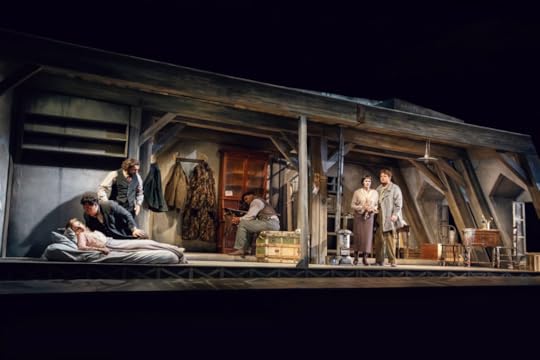 L – R: Long Long (Rodolfo), Szymon Mechliński (Marcello), Emma Marhefka (Musetta), Sylvia D’Eramo (Mimì), photo by Curtis Brown for the Santa Fe Opera
L – R: Long Long (Rodolfo), Szymon Mechliński (Marcello), Emma Marhefka (Musetta), Sylvia D’Eramo (Mimì), photo by Curtis Brown for the Santa Fe OperaYou think you’ve gotten over La bohème. Then a performance comes along and shatters your defenses, breaking your heart again…
My review of James Robinson’s new production spans the length of the 2025 Santa Fe Opera season is online here:
James Robinson’s new production of Puccini’s ubiquitous classic opened Santa Fe Opera’s 2025 season in June and will close it later this month. With its finely observed details and an emotional realism that doesn’t coast on sentimentality, it makes a fitting bookend to a summer that has balanced tradition with reinvention …
July 31, 2025
Showbiz and Shadows: ‘Rigoletto’ at Santa Fe Opera
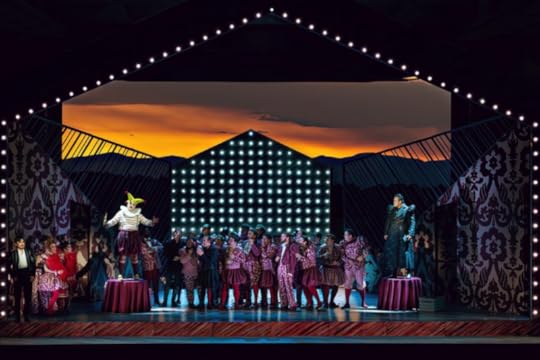 Duke Kim (Duke), Michael Chioldi (Rigoletto), Le Bu (Count Monterone), the Santa Fe Opera Chorus in Rigoletto at Santa Fe Opera (Photo: Curtis Brown)
Duke Kim (Duke), Michael Chioldi (Rigoletto), Le Bu (Count Monterone), the Santa Fe Opera Chorus in Rigoletto at Santa Fe Opera (Photo: Curtis Brown) It’s great to be back in Santa Fe. Here’s my take on the first of this week’s five productions @Santa Fe Opera:
Santa Fe Opera’s new Rigoletto delivers flashes of vitality that help compensate for a staging that is often muddled. From the outset, Carlo Montanaro’s conducting signalled an intense level of involvement from the orchestra. The opening curse motif, stated a touch more aggressively than usual, is as emphatic as an oracle. …
July 21, 2025
Yes, Chef – With Strings Attached
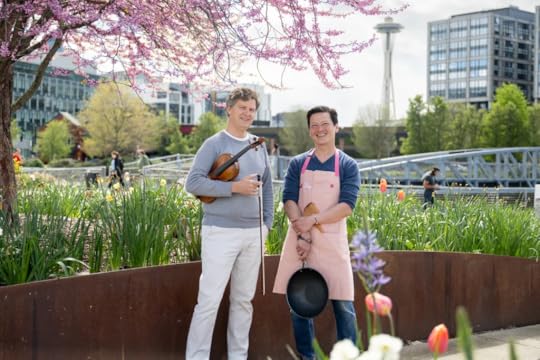 Violinist James Ehnes, Seattle Chamber Music Society artistic director, with cookbook author J. Kenji López-Alt have cooked up another music-and-food evening called Tasting Notes II on July 25. (Chona Kasinger)
Violinist James Ehnes, Seattle Chamber Music Society artistic director, with cookbook author J. Kenji López-Alt have cooked up another music-and-food evening called Tasting Notes II on July 25. (Chona Kasinger)My story on Seattle Chamber Music Society’s upcoming second edition of the Tasting Notes program:
Before they ever shared a stage, James Beard media award-winning cookbook author J. Kenji López-Alt and violinist James Ehnes had already discovered a mutual obsession with the art of cooking and Beethoven string quartets. ..
July 17, 2025
Another Evening at Seattle Chamber Music Society’s 2025 Summer Festival
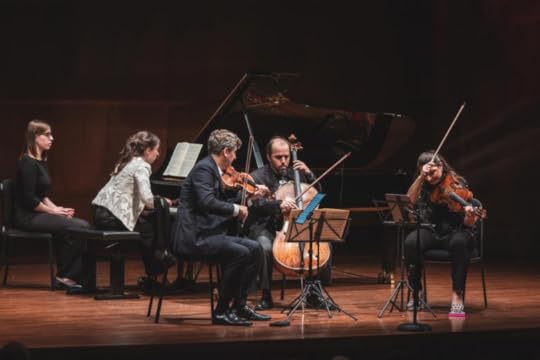 l to r: Yulianna Avdeeva, James Ehnes, Efe Baltacıgil and Milena Pajaro-van de Stadt; photo: Jenna Poppe
l to r: Yulianna Avdeeva, James Ehnes, Efe Baltacıgil and Milena Pajaro-van de Stadt; photo: Jenna PoppeFrom my review for The Strad:
With the other major classical institutions largely on summer hiatus, the Seattle Chamber Music Society takes centre stage in July, commanding the city’s musical life with a month-long festival that has been packing Benaroya Hall’s chamber music venue. Its varied slate of mainstage concerts, related events and guest artists has become a cultural fixture. Indeed, SCMS is expanding its presence with the recent announcement of an extended year-round season of offerings….
July 11, 2025
Anne Akiko Meyers: Champion of Contemporary Music
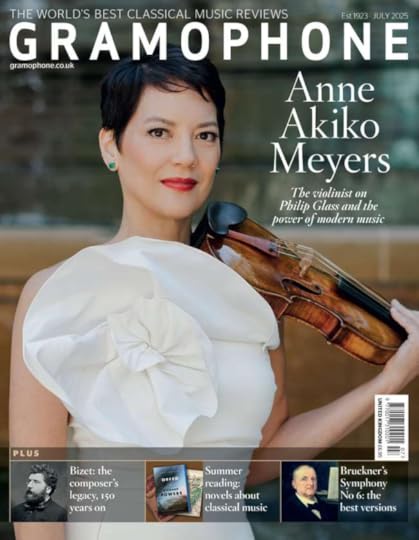
Even before the year reached its mid-point, Anne Akiko Meyers had released her third album of 2025, each strikingly different and, characteristically, showcasing new works she has commissioned.
My profile of this extraordinary violinist – and human being – is the cover story of this month’s Gramophone:
‘Curiosity’ doesn’t do justice to the force that drives Anne Akiko Meyers. A better word might be the German Neugier (literally, ‘greed for the new’), which suggests not just a hunger for the unknown, but an urgent, almost ravenous pursuit – a term that has a more active and impassioned meaning than does its English counterpart…
July 10, 2025
Bach’s Lost ‘Markus-Passion’ Imagined Anew – with a Dramatic Twist
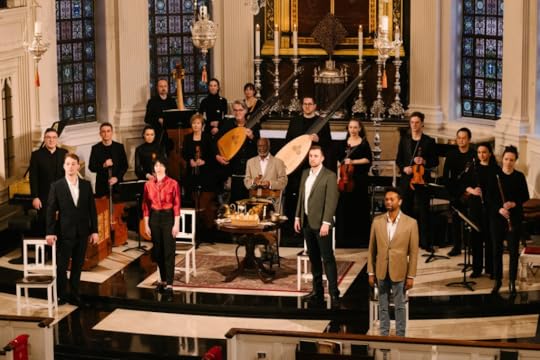 A recent performance of Bach’s “Markus Passion” in New York City featured Chatham Baroque and soloists (left to right, front row) Cody Bowers, Pascale Beaudin, Joseph Marcell, James Reese and… (Tatiana Daubek)
A recent performance of Bach’s “Markus Passion” in New York City featured Chatham Baroque and soloists (left to right, front row) Cody Bowers, Pascale Beaudin, Joseph Marcell, James Reese and… (Tatiana Daubek)Sacred music lay at the heart of Johann Sebastian Bach’s creative life. His vast output includes hundreds of choral works written for the principal churches in Leipzig, Germany, where he oversaw musical programming….
July 8, 2025
Smolder and Spark: Seattle Chamber Music Society Launches Its 2025 Summer Festival
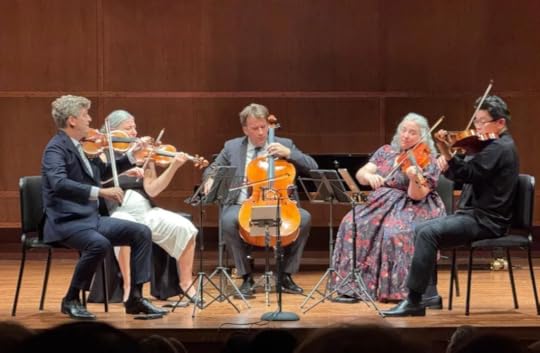 Ehnes Quartet with Beth Guterman Chu; image (c) Jorge Gustavo Elias
Ehnes Quartet with Beth Guterman Chu; image (c) Jorge Gustavo EliasI covered Sunday’s opening concert for Bachtrack:
The Seattle Chamber Music Society has not only emerged from the pandemic slump stronger than ever but seems to have hit on a golden formula. The opening concert of its month-long 2025 Summer Festival attracted a devoted audience to fill downtown’s 536-seat Nordstrom Recital Hall to near capacity – even before the concert officially began…
June 25, 2025
Happy Birthday to João Carlos Martins!
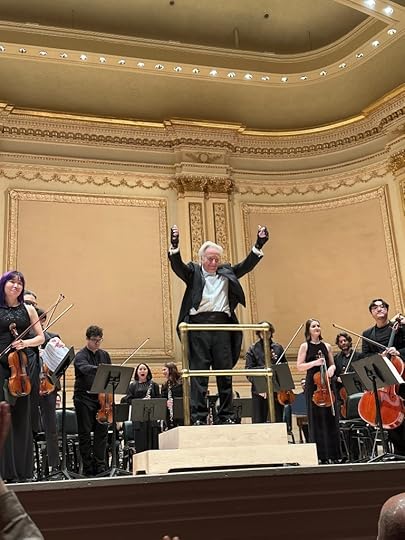 João Carlos Martins at Carnegie Hall Farewell Concert, 9 May 2025; photo: Jorge Gustavo Elias
João Carlos Martins at Carnegie Hall Farewell Concert, 9 May 2025; photo: Jorge Gustavo EliasHappy 85th birthday to o Maestro, João Carlos Martins! Born on 25 June 1940 in São Paulo, Martins established himself as one of the most brilliant keyboard interpreters of Johann Ses=bastian Bach in the second half of the 20th century.
Yet his Bach legacy is just one component of an artistic journey marked by both acclaim and adversity. João Carlos Martins’s story is as much about resilience and reinvention as it is about musical brilliance. Following prodigious beginnings – he made his Carnegie Hall debut at age 20 – repeated injuries to his hands forced Martins to step away from the piano, just as he was reaching the height of his international career. But rather than retreat from music, he redirected his focus to conducting, bringing the same fervor and eloquence to the podium that once defined his playing.
Martins additionally became an enormously influential cultural force in Brazil. Through his Bachiana Foundation, he has brought classical music to thousands of young people, many from underserved communities, creating access where there was none. Alongside this work with the Fundação Bachiana, Martins has also been a champion of Latin American composers.
His initiatives have blended high artistic standards with social impact, forging a vision of music as both an expressive art and a tool for transformation. Under his leadership, the Bachiana Filarmônica SESI-SP has become one of Brazil’s most dynamic cultural foundations – a platform for emerging talent and a vehicle for national pride, performing everywhere from favelas to major concert halls.
Martins’s late-career return to the keyboard – made possible by specially adapted bionic gloves – has added an inspiring new chapter to an already remarkable artistic narrative. Following his moving farewell concert at Carnegie Hall last month, Martins continues to extend a career that has continually defied limitation as he devotes himself to a broad new initiative to improve music education across Brazil.
Feliz Aniversário, Maestro! Your artistry continues to resonate far beyond the concert hall.
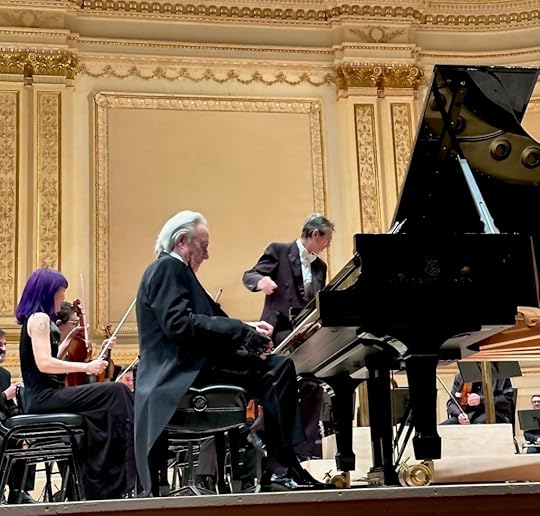 João Carlos Martins at Carnegie Hall Farewell Concert, 9 May 2025; photo: Jorge Gustavo Elias
João Carlos Martins at Carnegie Hall Farewell Concert, 9 May 2025; photo: Jorge Gustavo EliasAn archive of JCM videos can be found here.
June 24, 2025
San Francisco Opera’s “La Bohème” Paints Love in Hindsight
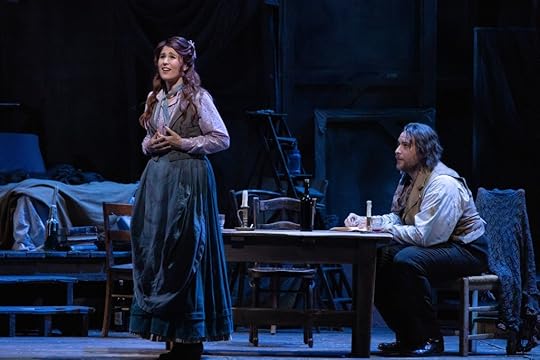 Nicole Car as Mimì and Evan LeRoy Johnson as Rodolfo in Puccini’s “La Bohème.”
Nicole Car as Mimì and Evan LeRoy Johnson as Rodolfo in Puccini’s “La Bohème.”
Photo: Matthew Washburn/San Francisco Opera
Since its founding in 1923, San Francisco Opera has maintained a love story of its own with La Bohème. The company actually opened with a performance of the beloved classic, cementing its identity with Puccini’s story of young love and youthful illusions. One thing this summer’s revival makes clear: when done persuasively, La Bohème seems immune to aging, undiminished in its emotional pull.
John Caird’s production, which originated in 2012 and first arrived at the War Memorial Opera House in 2014, with a revival in 2017, was presented as part of this summer’s shorter-than-usual season alongside a gripping interpretation of another great opera by a youthful artist in the process of making pivotal discoveries about what opera can do: Idomeneo, by the 20-something Mozart. In this revival of Caird’s original staging by Katherine M. Carter, the chemistry between the two main couples and among their circle of close friends gained a dramatic clarity that was believable.
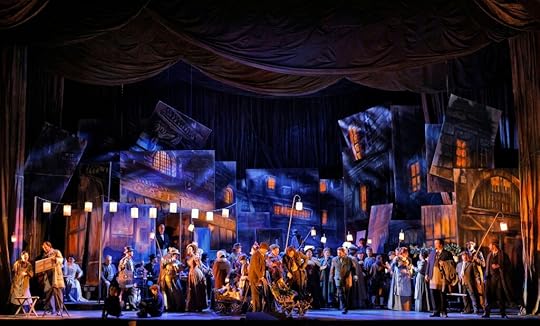 Act II of Puccini’s “La Bohème.”
Act II of Puccini’s “La Bohème.”
Photo: Cory Weaver/San Francisco Opera
A visual metaphor for the intensity of their dreams and idealism emerges in designer David Farley’s sets, which seem filtered through the imagination of the painter Marcello – as if memory itself were the canvas. Instead of a cosy view of the Parisian skyline, the distinctly crowded and cluttered garret is framed by panels that seem to be his own creation, works in progress. In the crowd scene at Momus, the wintry city is populated by still more painted façades that verge on abstraction, Cubistally tilted as if to hint at the transformation of experiences recollected from a distance, as they become stylized, mythologized. While also nodding to the aesthetic of Toulouse-Lautrec and the Belle Époque, the visual world inhabited by this Bohème wasat times almost dreamlike, even surreal.
Puccini’s achievement in this opera, bolstered by his collaboration with librettists Luigi Illica and Giuseppe Giacosa, gains traction from the varying manifestations of community among these young people: the cramped garret coming alive with roughhousing banter and energy and the glittering Café Momus brimming with a chaotic joy and sense of possibility against all the odds.
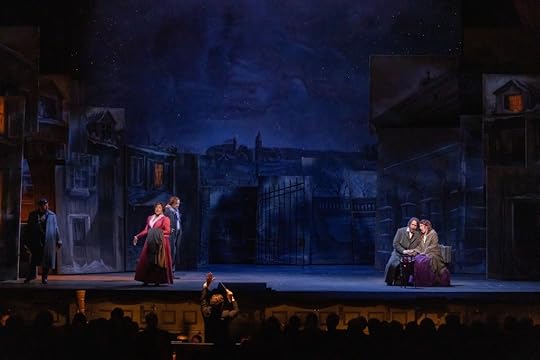 Ramón Tebar conducts the San Francisco Opera Orchestra with Brittany Renee as Musetta, Lucas Meachem as Marcello, Evan LeRoy Johnson as Rodolfo, and Nicole Car as Mimì in Puccini’s “La Bohème.”
Ramón Tebar conducts the San Francisco Opera Orchestra with Brittany Renee as Musetta, Lucas Meachem as Marcello, Evan LeRoy Johnson as Rodolfo, and Nicole Car as Mimì in Puccini’s “La Bohème.”
Photo: Matthew Washburn/San Francisco Opera
Much has been written about La Bohème as an opera of Romantic nostalgia, but this production underscores its deeper structure as a work of memory. Puccini’s savvy recapitulation of musical material – most movingly in the final act’s return to the music of Mimì and Rodolfo’s first meeting – carried incalculable expressive weight in Ramón Tebar’s sensitively detailed conducting, a highlight of the production. With his fine ear for balance and unwavering attention to the colors and harmonic richness of Puccini’s score, he had the orchestra paint in layered brushstrokes of timbre, shaping phrases with warmth and elasticity.
I heard the “alternate” cast on June 18. As Rodolfo, tenor Evan LeRoy Johnson made a welcome impression with his hefty, burnished tone and grounded stage presence. His rapport with Australian soprano Nicole Car as Mimì allowed him to trace an arc from self-conscious artist to grief-stricken lover. Car, in turn, conveyed Mimì’s innocence and vulnerability without reducing her to frailty. Even in the character’s earliest moments, there was a quiet self-awareness beneath the surface. Car uncovered more psychological nuance than is often seen in the third-act encounter with Rodolfo, singing with radiant control across the range. Her resonant low notes lent unexpected weight to a role sometimes misconstrued as a passive victim.
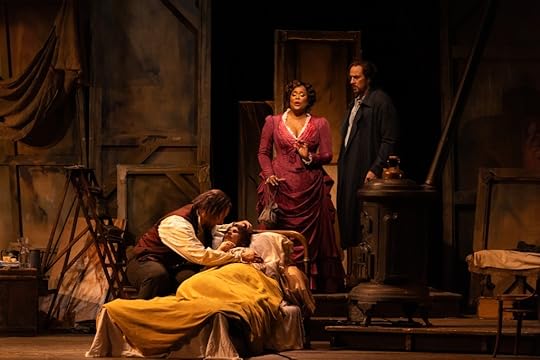 Evan LeRoy Johnson as Rodolfo, Nicole Car as Mimì, Brittany Renee as Musetta, and Lucas Meachem as Marcello in Puccini’s “La Bohème.”
Evan LeRoy Johnson as Rodolfo, Nicole Car as Mimì, Brittany Renee as Musetta, and Lucas Meachem as Marcello in Puccini’s “La Bohème.”
Photo: Matthew Washburn/San Francisco Opera
Filling in for the originally announced Will Liverman, baritone Lucas Meachem sang Marcello for the full run, bringing the painter to life with vocal vitality and a sharply etched dramatic immediacy through telling details, like his hint of jaded disdain when he first interacts with Mimì at Momus. He emerged as the opera’s emotional linchpin, bridging the bohemians’ slapstick and the lovers’ tragedy. His scenes with Rodolfo had the ease of real camaraderie – and rivalry.
As Musetta, soprano Brittany Renee lit up the stage with a performance abounding in vocal charisma and larger-than-life presence that also amplified the somewhat underworked Toulouse-Lautrec angle. Her “Quando me’n vo’” was anything but coquettish posturing but a declaration of unapologetic vitality. At the same time, she allowed a genuine compassion for Mimì to emerge with affecting sincerity in the deathbed watch.
There was much to enjoy in the detailed work of the companions as well. Bogdan Talos made a dignified and ultimately touching Colline, keeping a mostly detached air until the death scene released a surge of directness. His “Vecchia zimarra” felt like an intimate farewell to youth itself. Another highlight of the production was Samuel Kidd’s vividly observed portrayal of Schaunard (the one actual musician among these Bohemians), especially in his gleefully morbid story of how a dead parrot brought a windfall – a comic moment that, like so much in Bohème, holds a tragic echo in hindsight. Dale Travis brought seasoned comedic timing to his dual character roles as the landlord Benoit and sugar daddy Alcindoro. The SF Girls and Boys Choruses added charm to the Café Momus scene.
But what gave this performance its distinctive character was the sensitive, detailed conducting of Ramón Tebar. Making his company debut, the Spanish conductor proved a superb collaborator – very much a singers’ conductor – with an ear for balance and a painter’s attention to color. He brought out the harp’s glitter, the dark undertow of strings beneath bright melodies, and the often-overlooked harmonic richness of Puccini’s score.
As Larry Rothe insightfully writes in his beautiful program essay, Rodolfo, in retrospect, is not a novice in love but an artist transformed by a singular experience: “He hears himself pleading his case to Mimì in a new voice, honest and unguarded … Mimì, as Rodolfo recalls her, will always illuminate the memory of those rough days … those days that, for all their hardship, will always bear the tender ache suggested in that pivotal rising and falling fourth [of Rodolfo’s motif].”
That “tender ache” lingered well after Rodolfo’s cries of despair in this wonderful revival, reminding us not just of the pain of loss, but of how art redeems it – by turning memory into music.
June 23, 2025
Ludovic Morlot Returns to Lead Seattle Symphony’s Season-Closing Showcase
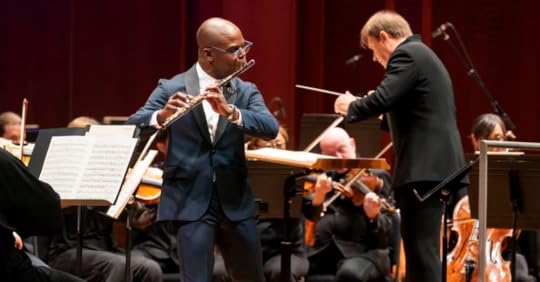 Ludovic Morlot conducts the Seattle Symphony, with soloist Demarre McGill
Ludovic Morlot conducts the Seattle Symphony, with soloist Demarre McGillWith Seattle Symphony on the cusp of a new chapter – music director designate Xian Zhang takes the reins in September – this season-closing program offered a vivid snapshot of the ensemble’s artistic breadth. …
Thomas May's Blog



